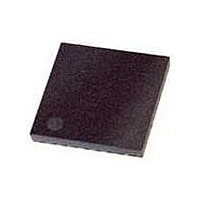ATTINY861-15MZ Atmel, ATTINY861-15MZ Datasheet - Page 77

ATTINY861-15MZ
Manufacturer Part Number
ATTINY861-15MZ
Description
MCU AVR 8K FLASH 15MHZ 32-QFN
Manufacturer
Atmel
Series
AVR® ATtinyr
Datasheet
1.ATTINY861-15MZ.pdf
(236 pages)
Specifications of ATTINY861-15MZ
Package / Case
32-VQFN Exposed Pad, 32-HVQFN, 32-SQFN, 32-DHVQFN
Voltage - Supply (vcc/vdd)
2.7 V ~ 5.5 V
Operating Temperature
-40°C ~ 125°C
Speed
16MHz
Number Of I /o
16
Eeprom Size
512 x 8
Core Processor
AVR
Program Memory Type
FLASH
Ram Size
512 x 8
Program Memory Size
8KB (8K x 8)
Data Converters
A/D 11x10b
Oscillator Type
Internal
Peripherals
Brown-out Detect/Reset, POR, PWM, WDT
Connectivity
USI
Core Size
8-Bit
Processor Series
ATTINY8x
Core
AVR8
Data Bus Width
8 bit
Data Ram Size
512 B
Interface Type
SPI
Maximum Clock Frequency
16 MHz
Number Of Programmable I/os
16
Number Of Timers
2
Maximum Operating Temperature
+ 85 C
Mounting Style
SMD/SMT
3rd Party Development Tools
EWAVR, EWAVR-BL
Development Tools By Supplier
ATAVRDRAGON, ATSTK500, ATSTK600, ATAVRISP2, ATAVRONEKIT, ATAVRMC320
Minimum Operating Temperature
- 40 C
On-chip Adc
10 bit, 11 Channel
Lead Free Status / RoHS Status
Lead free / RoHS Compliant
Available stocks
Company
Part Number
Manufacturer
Quantity
Price
Company:
Part Number:
ATTINY861-15MZ
Manufacturer:
ATMEL
Quantity:
1 465
- Current page: 77 of 236
- Download datasheet (2Mb)
14.6.1
14.6.2
14.6.3
14.7
2588B–AVR–11/06
Output Compare Unit
Input Capture Trigger Source
Noise Canceler
Using the Input Capture Unit
The default trigger source for the Input Capture unit is the Input Capture pin (ICP0).
Timer/Counter0 can alternatively use the Analog Comparator output as trigger source for the
Input Capture unit. The Analog Comparator is selected as trigger source by setting the Analog
Comparator Input Capture Enable (ACIC0) bit in the Timer/Counter Control Register A
(TCCR0A). Be aware that changing trigger source can trigger a capture. The Input Capture Flag
must therefore be cleared after the change.
Both the Input Capture pin (ICP0) and the Analog Comparator output (ACO) inputs are sampled
using the same technique as for the T0 pin
identical. However, when the noise canceler is enabled, additional logic is inserted before the
edge detector, which increases the delay by four system clock cycles. An Input Capture can also
be triggered by software by controlling the port of the ICP0 pin.
The noise canceler improves noise immunity by using a simple digital filtering scheme. The
noise canceler input is monitored over four samples, and all four must be equal for changing the
output that in turn is used by the edge detector.
The noise canceler is enabled by setting the Input Capture Noise Canceler (ICNC0) bit in
Timer/Counter Control Register B (TCCR0B). When enabled the noise canceler introduces addi-
tional four system clock cycles of delay from a change applied to the input, to the update of the
ICR0 Register. The noise canceler uses the system clock and is therefore not affected by the
prescaler.
The main challenge when using the Input Capture unit is to assign enough processor capacity
for handling the incoming events. The time between two events is critical. If the processor has
not read the captured value in the ICR0 Register before the next event occurs, the ICR0 will be
overwritten with a new value. In this case the result of the capture will be incorrect.
When using the Input Capture interrupt, the ICR0 Register should be read as early in the inter-
rupt handler routine as possible. The maximum interrupt response time is dependent on the
maximum number of clock cycles it takes to handle any of the other interrupt requests.
Measurement of an external signal’s duty cycle requires that the trigger edge is changed after
each capture. Changing the edge sensing must be done as early as possible after the ICR0
Register has been read. After a change of the edge, the Input Capture Flag (ICF0) must be
cleared by software (writing a logical one to the I/O bit location). For measuring frequency only,
the trigger edge change is not required (if an interrupt handler is used).
The comparator continuously compares Timer/Counter (TCNT0) with the Output Compare Reg-
isters (OCR0A and OCR0B), and whenever the Timer/Counter equals to the Output Compare
Regisers, the comparator signals a match. A match will set the Output Compare Flag at the next
timer clock cycle. In 8-bit mode the match can set either the Output Compare Flag OCF0A or
OCF0B, but in 16-bit mode the match can set only the Output Compare Flag OCF0A as there is
only one Output Compare Unit. If the corresponding interrupt is enabled, the Output Compare
Flag generates an Output Compare interrupt. The Output Compare Flag is automatically cleared
(Figure 13-1 on page
ATtiny261/461/861
71). The edge detector is also
77
Related parts for ATTINY861-15MZ
Image
Part Number
Description
Manufacturer
Datasheet
Request
R

Part Number:
Description:
Manufacturer:
Atmel Corporation
Datasheet:

Part Number:
Description:
Manufacturer:
Atmel Corporation
Datasheet:

Part Number:
Description:
IC MCU AVR 8K FLASH 20MHZ 32-QFN
Manufacturer:
Atmel
Datasheet:

Part Number:
Description:
IC MCU AVR 8K FLASH 20MHZ 20SOIC
Manufacturer:
Atmel
Datasheet:

Part Number:
Description:
MCU AVR 8K FLASH 15MHZ 20-SOIC
Manufacturer:
Atmel
Datasheet:

Part Number:
Description:
MCU AVR 8KB FLASH 15MHZ 32-VQFN
Manufacturer:
Atmel
Datasheet:

Part Number:
Description:
Microcontrollers (MCU) 8kB Flash 0.512kB EEPROM 16 I/O Pins
Manufacturer:
Atmel
Datasheet:

Part Number:
Description:
8-bit Microcontrollers - MCU 8KB FL 512B EE 512B SRAM 20MHZ IND 5V
Manufacturer:
Atmel

Part Number:
Description:
IC, MCU, 8BIT, 2K FLASH, 20SOIC
Manufacturer:
Atmel
Datasheet:

Part Number:
Description:
IC, MCU, 8BIT, 2K FLASH, 20PDIP
Manufacturer:
Atmel
Datasheet:













